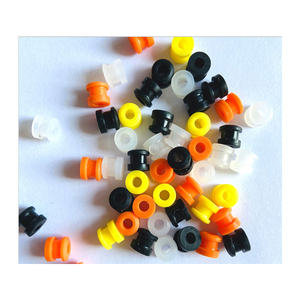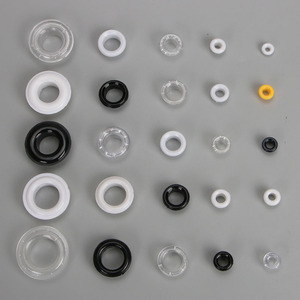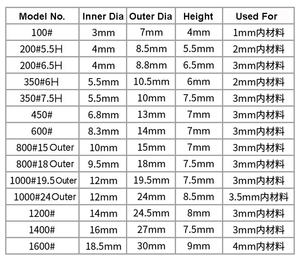(656 products available)









































































































































































The 3mm grommet is a small metallic or plastic ring that is used to reinforce holes in materials. It is used in various applications, including tents, sails, and curtains. It comes in different types based on their material composition and intended application. Here are some of them:
Metal Grommets
Metal grommets are the most common type. They are made of brass, stainless steel, or aluminum. Metal grommets are used in applications that involve friction or require a strong hold, such as in tarpaulin, tents, and industrial curtains. They are preferred because they are durable and can withstand harsh environmental conditions. For instance, brass grommets resist corrosion and rust, making them suitable for outdoor applications. Stainless steel grommets are more robust and are used in heavy-duty applications.
Plastic or Nylon Grommets
These grommets are made from high-density polyethylene (HDPE), nylon, or polyvinyl chloride (PVC). Plastic grommets are preferred in applications where the material being reinforced is also plastic or where there is a need to avoid metal for aesthetic or functional reasons. For instance, they are commonly used in shower curtains and some types of sails. Nylon grommets are flexible and can withstand a wide range of temperatures, making them suitable for various indoor and outdoor applications.
Rubber Grommets
Rubber grommets are used to provide both reinforcement and a seal. They are ideal for applications where water or air tightness is necessary, such as in electrical wiring or plumbing. The elasticity of rubber allows it to conform to the shape of the hole, providing a tight seal. Silicone rubber grommets offer even better temperature resistance and durability, making them suitable for high-temperature applications.
Fabric Grommets
These grommets are made from cotton or synthetic fabrics and are reinforced with a ring. They are used in applications like curtains and drapes, where they serve both functional and decorative purposes. Fabric grommets blend well with the material they are reinforcing, providing a neat appearance. They are available in various colors and patterns to match different types of fabrics.
3mm grommets are small, circular metal or plastic rings used to reinforce holes in materials such as fabric, paper, or leather. They typically come in various designs, each catering to specific applications and requirements. Here are some key design aspects of 3mm grommets:
Material
Grommets are produced from various materials, including plastic, aluminum, and brass. Plastic grommets are lightweight and corrosion-resistant, making them ideal for outdoor applications. Aluminum grommets are robust and lightweight, perfect for fabrics like tents and tarps. Brass grommets, though heavier, offer superior corrosion resistance and durability, making them suitable for leather and heavy-duty fabrics.
Shape and Size
3mm grommets are usually circular with a diameter of 3mm. This small size makes them suitable for lightweight materials and applications, such as securing threads or small cables. The shape is consistent across different designs, ensuring a snug fit for various materials.
Flange Design
The flange, the part of the grommet that sits on the surface of the material, comes in different designs. Some grommets have a flat flange that provides a low profile, while others may have a slightly raised or beveled flange for better grip and adherence. The flange design can affect the grommet's attachment method, either through adhesive, sewing, or mechanical fastening.
Reinforcement Options
Some 3mm grommets come with additional reinforcement features, such as ribs or grooves on the inner side of the ring. These features enhance the grommet's grip on the material and prevent it from slipping or tearing over time. Reinforcement options are crucial for applications involving high tension or frequent use.
Attachment Methods
Grommets can be attached to materials using various methods. Some are designed for adhesive application, providing a simple peel-and-stick solution. Others may require mechanical fastening techniques, such as using a setting tool or die to compress the grommet into the material. Sewing grommets into the fabric is another common method, ensuring a secure and permanent attachment.
Compatibility with Different Materials
3mm grommets are versatile and can be used with various materials, including fabric, leather, and plastics. Their design ensures a secure fit and reinforcement, making them ideal for applications like curtains, tarps, bags, and upholstery.
Weather Resistance
For outdoor applications, weather resistance is crucial. Aluminum and brass grommets offer better corrosion resistance than plastic ones, making them suitable for exposed environments. Additionally, some grommets may have a coating or treatment to enhance their resistance to moisture and UV rays.
3 mm grommets are flexible fastening devices that can be used in various applications. Their small diameter makes them ideal for lightweight materials and applications. Here are some wearing and matching suggestions:
Matching suggestions:
When worn, the 3mm grommet is usually paired with thin and flexible materials such as fabric, plastic, or rubber. Normally, they are integrated into the material by cutting a hole and inserting the grommet into the hole. In addition, they are usually reinforced by washers or by pressing the edge to form a secure fit. This gives a secure and waterproof fit. It is also ideal for applications requiring frequent use of the hole, like lacing systems or cable routing. This is because of its ability to distribute the stress over a larger area thereby preventing the material from tearing.
Wearing suggestions:
When wearing, the 3 mm grommet is usually incorporated in different applications. For instance, they are used in clothing, shoes, and accessories. This is usually for the purpose of providing a hole for laces, drawstrings, or ventilation. They can be used in curtains and blinds as well as in tents and tarps. Their primary role is to create a durable and waterproof hole in fabric. These small grommets are usually compatible with lightweight fabrics such as polyester, nylon, or canvas. Often, they are installed by cutting a small hole and pressing the grommet into the fabric. Sometimes, the installation may also require a washer or a reinforcing disc on the opposite side. This is to provide additional support and prevent the grommet from pulling out over time.
Q1: What materials are grommets typically made of?
A1: Grommet 3mm can be produced in a variety of materials. The most common ones include steel, brass, plastic, and aluminum. Steel and brass grommets are known for their strength and corrosion resistance, making them suitable for heavy-duty applications. Plastic grommets, on the other hand, are lightweight and rustproof, which makes them ideal for use in fabrics and other light materials. Aluminum grommets strike a balance between strength and weight, which makes them versatile for a wide range of applications.
Q2: How are grommets installed?
A2: The installation of grommets usually requires a few simple steps. First, a hole is cut into the material where the grommet will be placed. Next, the grommet is inserted into the hole, often with a washer on the opposite side to provide additional support. Finally, the grommet is secured using a tool like a grommet press or hammer, which compresses the grommet and washer to create a tight fit. Some installations might require specific tools or equipment to ensure a proper and secure fit.
Q3: What are some common applications of grommets?
A3: Grommets have a wide range of applications across different industries. They are commonly used in textiles to create holes for laces or cables, such as in curtains, tarps, and banners. In electrical applications, grommets are used to protect wires and cables as they pass through holes in metal or other hard materials. They are also used in automotive applications for sealing and protecting wires, hoses, and cables. Additionally, grommets find use in paper products, packaging, and various DIY projects.
Q4: Can grommets be reused?
A4: Once a grommet has been installed, it is not usually suitable for reuse. The installation process can deform the grommet or damage the material it was installed in, making it difficult to remove without causing further damage. While some plastic grommets might be removed and reinstalled with less risk of damage, it's generally recommended to use a new grommet for each installation to ensure a secure and effective fit.